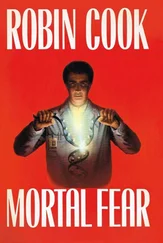“That’s correct,” said Dr. Ranade.
“But he knows where the diseased part of my brain is,” protested Lisa.
“Not well enough. But don’t worry. I’ll be there. There’ll be no pain. All you have to remember is no coughing and no sudden movements.”
Lisa’s reverie was cut short by a feeling of pain in her left forearm. Looking up she could see tiny bubbles rising up in a bottle over her head. Dr. Ranade had started the IV. He did the same thing in her right forearm, threading into her a long thin plastic tube. Then he adjusted the table so that it tilted slightly downward.
“Lisa,” said Carol Bigelow. “I’m going to catheterize you.”
Picking up her head, Lisa looked down. Carol was busy unwrapping a plastic covered box. Nancy Donovan, another scrub nurse, pulled back Lisa’s sheet exposing her from the waist down.
“Catheterize?” questioned Lisa.
“Yes,” said Carol Bigelow, pulling on loose rubber gloves. “I’m going to put a tube into your bladder.”
Lisa allowed her head to fall back. Nancy Donovan grasped Lisa’s legs and positioned them so that the soles of her feet were together while her knees were widely apart. She lay exposed for the world to see.
“I’m going to be giving you a medicine called mannitol,” explained Dr. Ranade. “It causes you to make a lot of urine.”
Lisa nodded as if she understood while she felt Carol Bigelow begin to scrub her genitals.
“Hi, Lisa, I’m Dr. George Newman. Do you remember me?”
Opening her eyes, Lisa gazed into another masked face. These eyes were blue. On the other side of her was another face with brown eyes.
“I’m the Chief Resident in Neurosurgery,” said Dr. Newman, “and this is Dr. Ralph Lowry, one of our Junior Residents. We’ll be helping Dr. Mannerheim as I explained to you yesterday.”
Before Lisa could respond she felt a sudden sharp pain between her legs, followed by a curious fullness in her bladder. She took a breath. She felt tape being placed on the inner part of her thigh.
“Just relax now,” said Dr. Newman without waiting for her to respond. “We’ll have you fixed up in no time.” The two doctors directed their interest to the series of X rays that lined the back walls.
The pace in the OR quickened. Nancy Donovan appeared with a steaming stainless steel tray of instruments, and with a loud crash she heaved it on top of a nearby table. Darlene Cooper, another scrub nurse, who was already gowned and gloved, reached into the sterile instruments and began to arrange them on a tray. Lisa turned her head when she saw Darlene Cooper lift out a large drill.
Doctor Ranade wrapped a blood pressure cuff around Lisa’s right upper arm. Carol Bigelow exposed Lisa’s chest and taped on EKG leads. Soon the sonar-like beeps from the cardiac monitor competed with John Denver on the transistor.
Dr. Newman came back from studying the X rays and positioned Lisa’s shaved head. With his pinky on her nose and his thumb on the top of her head, he drew a line with a marking pen. The first line went from ear to ear over the top of her head. The second line bisected this one, starting at the middle of the forehead and extending back to the occipital area.
“Now, Lisa, turn your head to the left,” said Dr. Newman.
Lisa kept her eyes closed. She felt a finger palpate the ridge of bone that ran back from her right eye toward her right ear. Then she felt the marking pen trace a looping line that began at her right temple and arched upward and backward ending behind her ears. The line defined a horseshoe-shaped area with Lisa’s ear at its base. This was to be the flap that Dr. Mannerheim had described.
An unexpected drowsiness coursed through Lisa’s body. It felt like the air in the room had become viscous and her extremities leaden. It took great effort for her to open her eyelids. Dr. Ranade smiled down at her. In one hand was her IV line; in the other hand a syringe.
“Something to relax you,” said Dr. Ranade.
Time became discontinuous. Sounds drifted in and out of her consciousness. She wanted to fall asleep but her body involuntarily fought against it. She felt herself being turned half on her side with her right shoulder elevated and supported by a pillow. With a sense of detachment she felt both wrists bound to a board that stuck out at right angles from the operating table. Her arms felt so heavy she couldn’t have moved them anyway. A leather cinch went around her waist securing her body. She felt her head scrubbed and painted. There were several sharp needles accompanied by fleeting pain before her head was clamped in some sort of vise. Despite herself, Lisa fell asleep.
Sudden intense pain awoke her with a start. She had no idea how much time had passed. The pain was located above her right ear. It occurred again. A cry issued from her mouth and she tried to move. Except for a tunnel of cloth directly in front of her face, Lisa was covered with layers of surgical drapes. At the end of the tunnel, she could see Dr. Ranade’s face.
“Everything is fine, Lisa,” said Dr. Ranade. “Don’t move now. They are injecting the local anesthetic. You’ll only feel it for a moment.”
The pain occurred again and again. Lisa felt like her scalp was going to explode. She tried to lift her arms only to feel the cloth restraints. “Please,” she shouted, but her voice was feeble.
“Everything is fine, Lisa. Try to relax.”
The pain stopped. Lisa could hear the doctors breathing. They were directly over her right ear.
“Knife,” said Dr. Newman.
Lisa cringed. She felt pressure, like a finger being pressed against her scalp and rotated around the line drawn by the marking pen. She could feel warm fluid on her neck through the drapes.
“Hemostats,” said Dr. Newman. Lisa could hear sharp metallic snaps.
“Raney clips,” said Dr. Newman. “And call Mannerheim. Tell him we’ll be ready for him in thirty minutes.”
Lisa tried not to think about what was happening to her head. Instead she thought about the discomfort in her bladder.
She called to Dr. Ranade and told him she had to urinate.
“You have a catheter in your bladder,” said Dr. Ranade.
“But I have to urinate,” said Lisa.
“Just relax, Lisa,” said Dr. Ranade. “I’ll give you a little more sleep medicine.”
The next thing Lisa was conscious of was the high-pitched whine of a gas-powered motor combined with a sense of pressure and vibration on her head. The noise was frightening because she knew what it meant. Her skull was being opened by a saw; she didn’t know it was called a craniotome. Thankfully there was no pain, although Lisa braced for it to occur at any moment. The smell of scorched bone penetrated the gauze drapes over her face. She felt Dr. Ranade’s hand take hers, and she was thankful for it. She pressed it as if it were her only hope of survival.
The sound of the craniotome died. The rhythmic beeping of the cardiac monitor emerged from sudden stillness. Then Lisa felt pain again, this time more like the discomfort of a localized headache. Dr. Ranade’s face appeared at the end of her tunnel of vision. He watched her as she felt the blood pressure cuff inflate.
“Bone forceps,” said Dr. Newman.
Lisa heard and felt bone crunching. It sounded very close to her right ear.
“Elevators,” said Dr. Newman.
Lisa felt several more twinges, followed by what seemed to her a loud snap. She knew her head was open.
“Damp gauze,” said Dr. Newman, in a matter-of-fact voice.
While still scrubbing his hands, Dr. Curt Mannerheim leaned over to look through the door into OR #21 and see the clock on the far wall. It was almost nine o’clock. At that moment, he saw his chief resident, Dr. Newman, step back from the table. The resident crossed his gloved hands on his chest, and walked over to study the X rays arranged on the view box. That could mean only one thing. The craniotomy was done and they were ready for the Chief. Dr. Mannerheim knew he didn’t have much time to spare. The investigative committee from the N.I.H. was due to arrive at noon. What was at stake was a twelve-million-dollar research grant that would support his research activities for the next five years. He had to get that grant. If he didn’t, he might lose his entire animal lab, and with it, the results of four years of work. Mannerheim was certain he was on the brink of finding the exact spot in the brain responsible for aggression and rage.
Читать дальше












